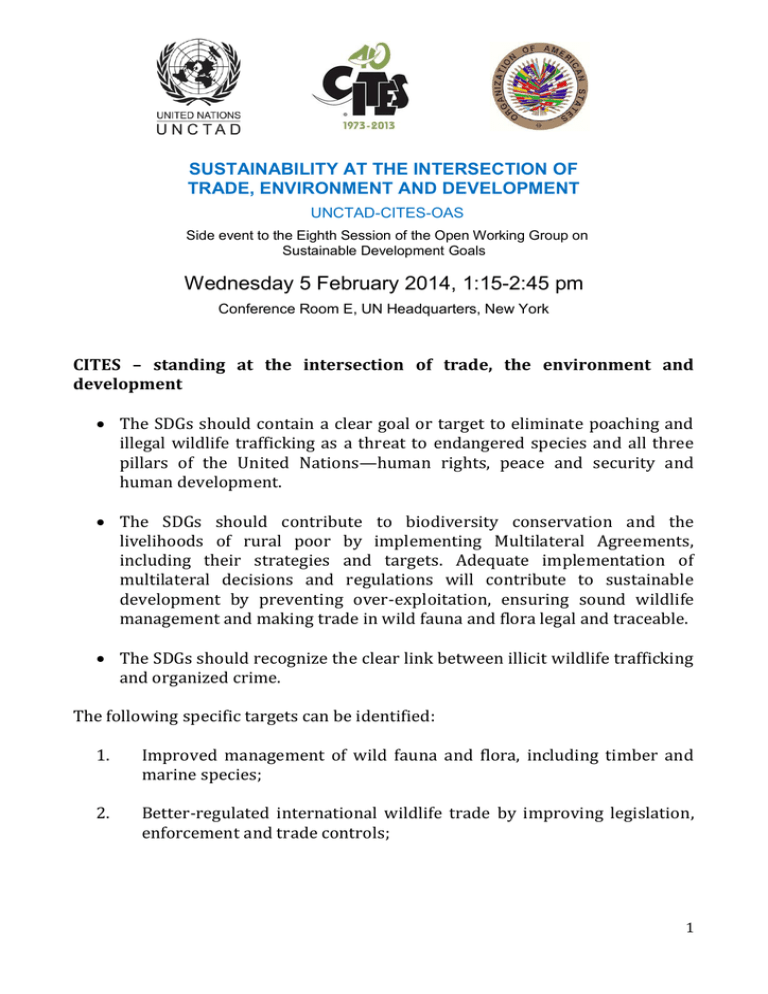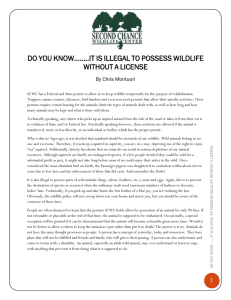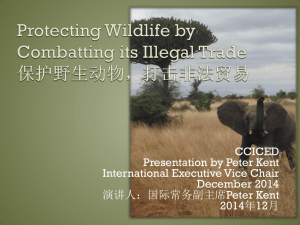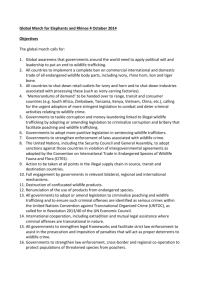Wednesday 5 February 2014, 1:15-2:45 pm
advertisement

SUSTAINABILITY AT THE INTERSECTION OF TRADE, ENVIRONMENT AND DEVELOPMENT UNCTAD-CITES-OAS Side event to the Eighth Session of the Open Working Group on Sustainable Development Goals Wednesday 5 February 2014, 1:15-2:45 pm Conference Room E, UN Headquarters, New York CITES – standing at the intersection of trade, the environment and development The SDGs should contain a clear goal or target to eliminate poaching and illegal wildlife trafficking as a threat to endangered species and all three pillars of the United Nations—human rights, peace and security and human development. The SDGs should contribute to biodiversity conservation and the livelihoods of rural poor by implementing Multilateral Agreements, including their strategies and targets. Adequate implementation of multilateral decisions and regulations will contribute to sustainable development by preventing over-exploitation, ensuring sound wildlife management and making trade in wild fauna and flora legal and traceable. The SDGs should recognize the clear link between illicit wildlife trafficking and organized crime. The following specific targets can be identified: 1. Improved management of wild fauna and flora, including timber and marine species; 2. Better-regulated international wildlife trade by improving legislation, enforcement and trade controls; 1 3. More effective prevention of illegal wildlife trade, with a particular focus on selected flagship species such as rhinos, elephants, great apes and big cats; 4. Sustain and enhance livelihoods of local communities and the rural poor that are highly dependent on wildlife resources. Relevance of wildlife as a natural and cultural keystone for the SDGs In human cultures everywhere, there are plants and animals that form the contextual underpinnings of a culture, as reflected in their key roles in diet, as materials, or in medicine. Every day, over 7 billion people are using wild fauna and flora in the form of food delicacies, lipsticks, chewing gums, perfumes, clothes, furniture and many other tangible products and services that contain ingredients provided by wildlife. In addition, these species often feature prominently in the language, ceremonies, and narratives of our indigenous peoples and can be considered cultural icons. “People of the deer”, the “Seahawks”, “town of the wild plums”, “people of the wild rice”…all around the globe, humans identify themselves and each other by their cultural and economic affiliations with particular species of plants and animals. The reliance of humans on other life-forms is unquestioned and should be embedded in the SDGs. In its resolution of 20 December proclaiming 3 march as World Wildlife Day, the General Assembly reaffirmed the intrinsic value of wildlife and its various contributions, including ecological, genetic, social, economic, scientific, educational, cultural, recreational and aesthetic, to sustainable development and human well-being, and recognized the important role of CITES in ensuring that international trade does not threaten the species’ survival. The Convention on International Trade in Endangered Species of Wild Fauna and Flora, known by its acronym CITES or ‘the Washington Convention’, is a multilateral environmental agreement between governments that regulates international trade in species of wild animals and plants is legal, sustainable and traceable. There are many cases where governments, corporations and consumers are inadvertently pursuing agendas that unsustainably utilize our natural capital. For instance, overfishing and excessive logging are destroying marine and forest life every day. When a species arrives on a CITES list, a number of clear and well-crafted requirements apply to importing and exporting States to ensure that any 2 international trade comes from legal sources and is sustainable, together with measures to deter illegal trade. A major challenge for Parties to the MEAs is the difficulty in meeting international obligations and specific requirements for several of their species. The SDGs should emphasize the importance of the rule of law and the need for implementation of international commitments. According to the third edition of the Global Biodiversity Outlook, produced for the Convention on Biological Diversity or CBD, CITES is one of the few tools that have contributed effectively to the achievement of the target endorsed by the World Summit on Sustainable Development and the CBD of significantly reducing the current rate of biodiversity loss by 2010. CITES has also contributed in a measurable manner to achieving the Millennium Development Goals. --------Relevance of poaching and illicit wildlife trafficking, including illegal logging and fishing for the SDGs On September 26, 2013, a high level discussion on poaching and illicit wildlife trafficking was held at a special high level side event at the 68th session of the UN General Assembly. The UN Deputy Secretary-General said that “Illegal trade in wildlife and endangered species is a threat to all three pillars of the United Nations—human rights, peace and security and human development”. The illegal wildlife trade—marine and terrestrial—is the fourth largest illegal trade globally after drugs, human trafficking and counterfeiting, totalling some $19 billion a year. The issue of illegal wildlife trafficking is raised in the technical papers prepared by the UN Secretariat for session eight of the Open Working Group on the Sustainable Development Goals. The Rio+20 “The Future we Want” Outcome Document states, “We recognize the economic, social and environmental impacts of illegal wildlife trade, where firm and strengthened action needs to be taken on both the supply and demand sides. In this regard, we emphasize the importance of effective international cooperation among relevant multilateral environmental agreements and international organizations.” The SDGs can help turn that statement into reality. With regard to peace and security, participants in the General Assembly high level side event discussion held on 26 September, 20131 stated that poaching and illicit wildlife trafficking should be regarded as a serious crime facilitated by corruption and linked to organized crime and militias in many countries. The 1 http://www.cites.org/eng/news/sg/2013/20130926_unga_side-event.php 3 illegal wildlife trade, whether on land or in the sea, poses a threat to the wellbeing of local communities and ecosystems, local people and national economies are deprived of secure recurrent income, of employment opportunities from wildlife tourism and other legal and sustainable uses of wildlife and in some cases it also poses a threat to national and regional security 2. Poaching and illegal wildlife trafficking threaten many species and the livelihoods of rural communities. There is particular attention today on the illegal killing of elephants for ivory smuggling. The population of African forest elephants has declined by 62% from 2002-11, and it is estimated that 96 elephants are poached every day for this illegal trade. There is growing evidence that this escalating poaching of elephants (and other endangered species) is run by, and in turn is funding, organized criminal syndicates, some of which are connected with terrorist and militia groups. To help stop the ivory trafficking and the elephant poaching , CITES has requested export, transit and consumer countries to adopt action plans to enforce in a coordinated manner the international prohibition on commercial ivory trade. CITES regulations, and enforcement and management efforts of elephant range States, are undermined when a single segment of the illegal ivory chain fails to do its work. 2 http://www.cites.org/eng/news/sundry/2014/20140203_un_sanctions.php 4








